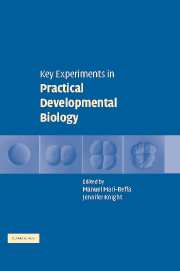Book contents
- Frontmatter
- Contents
- List of contributors
- Preface
- Introduction
- SECTION I GRAFTINGS
- SECTION II SPECIFIC CHEMICAL REAGENTS
- SECTION III BEAD IMPLANTATION
- SECTION IV NUCLEIC ACID INJECTIONS
- SECTION V GENETIC ANALYSIS
- SECTION VI CLONAL ANALYSIS
- SECTION VII IN SITU HYBRIDIZATION
- 17 Retinoic acid signalling controls anteroposterior patterning of the zebrafish hindbrain
- 18 Left–right asymmetry in the mouse
- SECTION VIII TRANSGENIC ORGANISMS
- SECTION IX VERTEBRATE CLONING
- SECTION X CELL CULTURE
- SECTION XI EVO–DEVO STUDIES
- SECTION XII COMPUTATIONAL MODELLING
- Appendix 1 Abbreviations
- Appendix 2 Suppliers
- Index
- Plate Section
- References
18 - Left–right asymmetry in the mouse
Published online by Cambridge University Press: 11 August 2009
- Frontmatter
- Contents
- List of contributors
- Preface
- Introduction
- SECTION I GRAFTINGS
- SECTION II SPECIFIC CHEMICAL REAGENTS
- SECTION III BEAD IMPLANTATION
- SECTION IV NUCLEIC ACID INJECTIONS
- SECTION V GENETIC ANALYSIS
- SECTION VI CLONAL ANALYSIS
- SECTION VII IN SITU HYBRIDIZATION
- 17 Retinoic acid signalling controls anteroposterior patterning of the zebrafish hindbrain
- 18 Left–right asymmetry in the mouse
- SECTION VIII TRANSGENIC ORGANISMS
- SECTION IX VERTEBRATE CLONING
- SECTION X CELL CULTURE
- SECTION XI EVO–DEVO STUDIES
- SECTION XII COMPUTATIONAL MODELLING
- Appendix 1 Abbreviations
- Appendix 2 Suppliers
- Index
- Plate Section
- References
Summary
OBJECTIVE OF THE EXPERIMENT From the outside vertebrates appear bilaterally symmetrical, with paired sensory organs and a symmetrical axial skeleton. The abdominal and thoracic organs, however, assume asymmetric positions with respect to the midline (situs solitus). The apex of the heart points to the left, the right and left lung differ with respect to lobation, the stomach and spleen are located on the left, the liver is located on the right, and the small and large intestines coil asymmetrically. Laterality is created during early embryogenesis. Embryological and genetic experiments in chick, frog, zebrafish and mouse have revealed a conserved asymmetric signaling cascade, which relays asymmetric cues from the embryonic midline to the lateral plate mesoderm and the forming organs.
The objective of the experiments detailed below is to visualize both molecular and morphological asymmetries in mouse embryos during development. Eight- and nine-day-old embryos will be isolated and asymmetric left-sided transcription of the homeobox transcription factor Pitx2 will be analyzed by whole-mount in situ hybridization (ISH). Morphological asymmetries will be observed both in embryos and adult mice.
DEGREE OF DIFFICULTY ISH requires basic molecular biological skills, in particular the handling of RNA. A prerequisite for isolation of mouse embryos is a facility to keep laboratory mice and a licence to kill experimental animals. Experience in recognizing plugs is required to set up timed matings. In addition, it is preferable that students have some previous work experience in dissection techniques using forceps, scissors and the stereomicroscope.
- Type
- Chapter
- Information
- Key Experiments in Practical Developmental Biology , pp. 217 - 230Publisher: Cambridge University PressPrint publication year: 2005

